|
TRAVEL IN WALES (continued)
Contents of this section
The Railway
Motor Transport
The Bicycle
The Railway
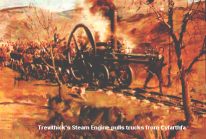 In 1804 Richard Trevithick drove the first
train from Cyfarthfa Ironworks to the Abercynon Canal carrying 70 passengers and
ten tons of produce, though this was a but a precursor to the explosion of rail development
in less than 40 years. Complaints began to be voiced about the congestion, which
was occurring on the Glamorganshire Canal. Before the middle of the century a new
form of transport was becoming available. This was steam-powered locomotion namely
the railway. Designed by Isambard Brunel and inspired by Anthony Hill of the Plymouth
Ironworks a railway was built and opened in 1841. Brunel was also involved in the
construction of the Vale of Neath railway. Engineered over difficult mountainous
terrain it was chiefly noted for its timber viaducts. In 1804 Richard Trevithick drove the first
train from Cyfarthfa Ironworks to the Abercynon Canal carrying 70 passengers and
ten tons of produce, though this was a but a precursor to the explosion of rail development
in less than 40 years. Complaints began to be voiced about the congestion, which
was occurring on the Glamorganshire Canal. Before the middle of the century a new
form of transport was becoming available. This was steam-powered locomotion namely
the railway. Designed by Isambard Brunel and inspired by Anthony Hill of the Plymouth
Ironworks a railway was built and opened in 1841. Brunel was also involved in the
construction of the Vale of Neath railway. Engineered over difficult mountainous
terrain it was chiefly noted for its timber viaducts.
From minor beginnings the railways spread everywhere, not only in Great Britain but
also throughout the world. In 1855 came the first rail shipment of coal from Treherbert
in the Rhondda to Cardiff. In addition to timber viaducts more permanent masonry
structures were built.
A particularly fine example is that at Cefn-Coed-y-Cymer erected for the Brecon and
Merthyr Railway in 1866. Tall and slim with fifteen arches it reached a height of
94 feet and an overall length of 561 feet.
The Great Western Railway Company with its brilliant engineer Isambard Kingdom Brunel
began to lay down tracks from Paddington in London towards the West Country and Wales.
This was in 1837. Soon the railway reached across the borders to South Wales. Not
at first directly but in 1886 came the Severn Rail Tunnel.
|
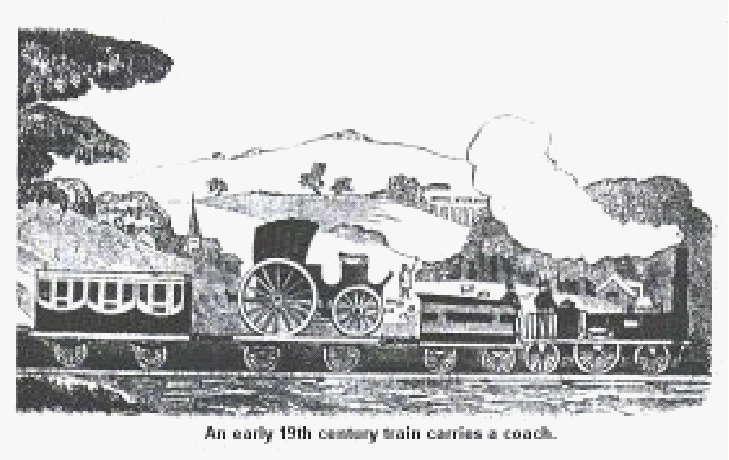
In the early 19th century the stagecoach was
gradually replaced by the steam train. The picture shows a compromise with a coach
loaded on a flat wagon.
|
|
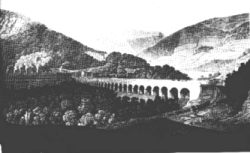
The undulating terrain in many areas was a
problem for the railway builders. One solution was the construction of elaborate
viaducts.
|
|
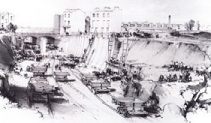
Another method of overcoming the variations
in levels was to dig cuttings
|
|
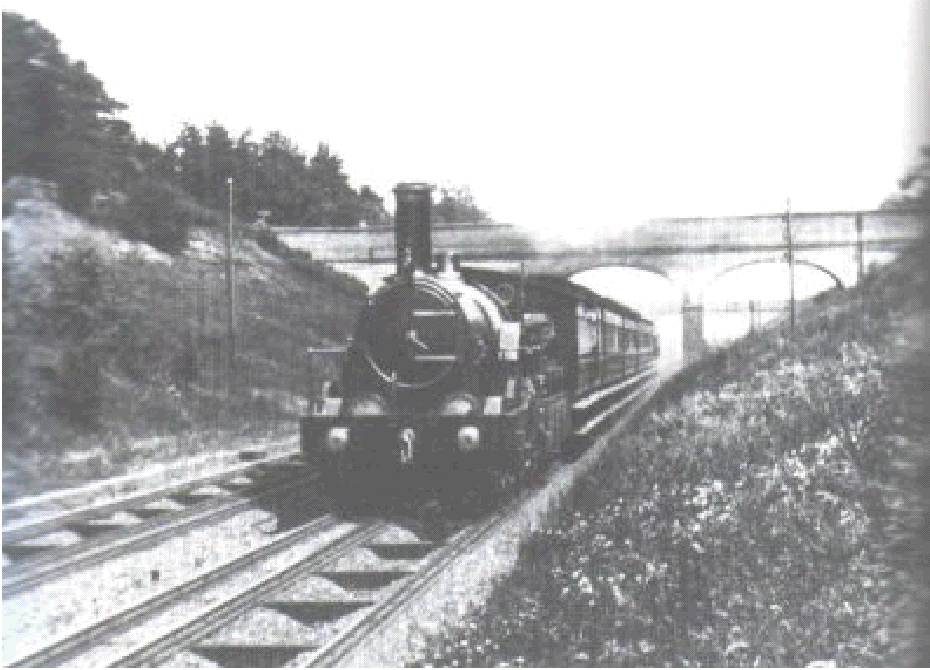
The great engineer, Isambard Kingdom Brunel,
laid his broad gauge westwards to Wales.
|
|
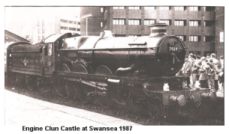
The Great Western Railway ran some of the finest
railway engines, not the least of them, this example.
|
The principal beneficiaries were the merchants and industrialists
who could now move their produce with ease. Of course the general public was quick
to take advantage of the cheaper fares and quicker journey times. Not that the first
carriages were all that different to stagecoaches, except that passengers could no
longer ride on top. The stagecoach proprietors were soon in financial difficulties;
they did try cutting fares, but soon only the routes from railway stations connecting
the places not on the rail system were still served by coaches. Whereas in 1845 an
express train would make the journey to Bristol from London on the broad gauge line
a distance of 118 miles would take only 2 hours 15 minutes; 46 miles an hour.
The rail network served not all the country at first. Some enterprising coach owners
arranged for their vehicles to meet trains and carry passengers to other destinations.
An advert from June 1868 announced the Royal Mail Coach leaving the Railway Hotel
at Narberth every morning at 7.55 AM. On the arrival of the down Mail train from
Paddington, and the up Mail train from Milford Haven, 8.05 AM. Arriving at the Angel
Hotel in Cardigan at 10.48 AM. returning from the Angel Hotel, Cardigan, at 2.00
PM. arriving at Narberth station in time for the up Mail from Milford Haven to Paddington
at 5 PM. and in time for the Express and Third Class Down trains to Milford Haven.
As a comparison between the service provided by the G.W.R. and coach travel, Cecil
Torr wrote in his book 'Small Talk at Wreyland, Devon', that in 1841 his father went
on the Defiance coach from London, Piccadilly at 4-30 PM. Stopped at Andover for
supper and Ilminster for breakfast. Allowing for stops the journey took 21 hours
at an average speed of 10 m.p.h. In March 1845 by train to Exeter took 10 1/4 hours
and in August 1846 by express train to Exeter the journey took only 6 1/4 hours.
The coach fare to Exeter was £3-10-0 with 1/4 added for tips; by train it cost
1st class £2-4-6 and £2-10-0 on the express train.
A South Wales Railway time table advertised four trains on week days from Chepstow
and Swansea calling at: Newport, Cardiff, Llantrissant, Bridgend, Pyle, Port Talbot,
Neath and Swansea with similar departures for trains travelling in the opposite direction.
The journey taking about 3 to 3 1/2 hours. There were two trains in each direction
on Sundays. Fares as follows:
1st class to Swansea from Chepstow or vice versa 15/-.
2nd class " " " " " "
10/-.
3rd class " " " " " "
6/3*.
*Chepstow to Swansea say 80 miles @ 75d = .94d per
mile
From the 1840s the rail network continued to grow. Villages and towns far from the
sea began to take railway excursions for their holidays at the seaside. Sunday school
outings would take an early train to places along the coasts which began to have
amusements and fairs. From a town up the valleys like Rhymney in 1858 there were
three trains in each direction to Cardiff. The fares were 4/2d, 3/1d and 2/- according
to classes. The fastest journey time was 17 minutes for 24 and a half miles.
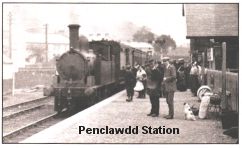 A day return to Cardiff cost 2/-. By 1904 there
were 14 trains each way and the fastest does the journey in an hour. Then the fares
were for the two classes 5/- and 3/-; day returns 4/9 or 3/2d. A day return to Cardiff cost 2/-. By 1904 there
were 14 trains each way and the fastest does the journey in an hour. Then the fares
were for the two classes 5/- and 3/-; day returns 4/9 or 3/2d.
From the early beginnings in the 1830s the railway enjoyed halcyon days, that is,
until one day the sound of motor car engines in the late 1890s began to spell out
the demise of the monopoly of rail travel. By this time there was a myriad of railway
companies each competing for business; some performed well, others were to soon be
forgotten. Then there were only four main companies-G.W.R.,S.R., L.M.S. and L.N.E.R.
back to the
top
Motor Transport
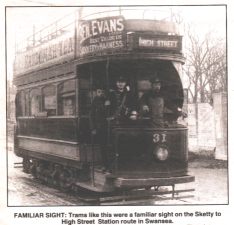 At first the motorcar was a vehicle only the
rich could afford to run privately for pleasure. Many towns had horse drawn buses,
but motor omnibuses supplanted these. Electricity supplied power to trams, which
had either a pick up from below ground or by overhead wire. Tracks were laid down
the centre of the roads and the trams clattered and rumbled along. The fares were
low and queues formed at stops. People had to climb steps to enter the tram from
the road. It was dangerous, the traffic was supposed to give way to boarding passengers,
but this still made people vulnerable. The main problem that led to the abandonment
of trams was this holding up of traffic at tram stops. Nostalgically all the trams
and tramways were destroyed except for a few like At first the motorcar was a vehicle only the
rich could afford to run privately for pleasure. Many towns had horse drawn buses,
but motor omnibuses supplanted these. Electricity supplied power to trams, which
had either a pick up from below ground or by overhead wire. Tracks were laid down
the centre of the roads and the trams clattered and rumbled along. The fares were
low and queues formed at stops. People had to climb steps to enter the tram from
the road. It was dangerous, the traffic was supposed to give way to boarding passengers,
but this still made people vulnerable. The main problem that led to the abandonment
of trams was this holding up of traffic at tram stops. Nostalgically all the trams
and tramways were destroyed except for a few like
|
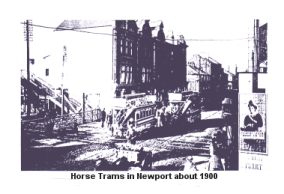
The first trams, as they were called, were drawn by horses.
|
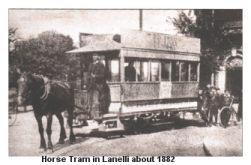 |
those that run along the sea front at Blackpool.
Motor transport even before the First World War had an advantage that the railways
could not compete with- this was that goods could be delivered door to door. Though
the railways built up a network of delivery vehicles businesses preferred to control
the way their own vehicles moved.
There were alternative sorts of vehicles steam powered cars and lorries. The former
were too erratic in their starting and although the larger lorries had a vogue that
lasted till the thirties in the 20th century, only an occasional vintage steam lorry
is seen on the roads. Steam traction engines share the same ethos among enthusiasts.
Like steam on the railways it seems that the mystique of exposed wheels and piston
rods has a masculine appeal.
The thirties had achieved little change on the railways. Expresses like the Flying
Scotsman and Royal Scot, could reach the speed of eighty miles an hour over quite
long distances. The road network in Britain was developing with bypasses and dual
carriageways. More and more cheaper cars like Fords, Austins and Morrises were available.
Prices just above £100 could be met on hire purchase. Even then the car was
not usually seen parked outside many houses in Wales.
|

The first buses were also horse-drawn.
|
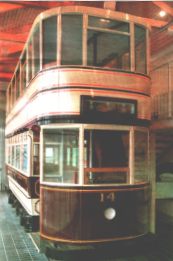
Soon the trams became electrified and the buses driven by petrol
and then diesel fuel.
|
|
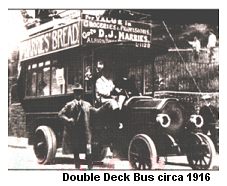
|
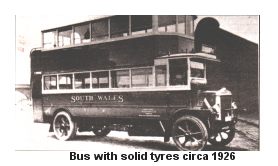
|
|
In the 1950s the trams disappeared, replaced by
more buses that made less traffic congestion.
|
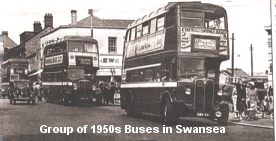
|
back to the
top
The Bicycle
One method of travelling had lasted for more than a century. This was the humble
bicycle. It had been the means of thousands of workers getting to their place of
employment. Not that the hilly terrain of Wales was the best surface to get from
place to place.
Nevertheless cycling clubs abounded during the thirties and for a long time after
the Second World War. Although the younger generation seemed to want a less energy
consuming means of transport. Motorcycling has had its enthusiasts even from the
same early days of the motorcar. It could be the death defying roar of a powerful
twin or the put-put of a pedal assisted moped. The motor scooter originated perhaps
in Italy and found its devotees after the war. Dressed in their flash and colourful
attire the riders and the girls on the pillion seats often terrorised seaside towns.
back to the
top
|